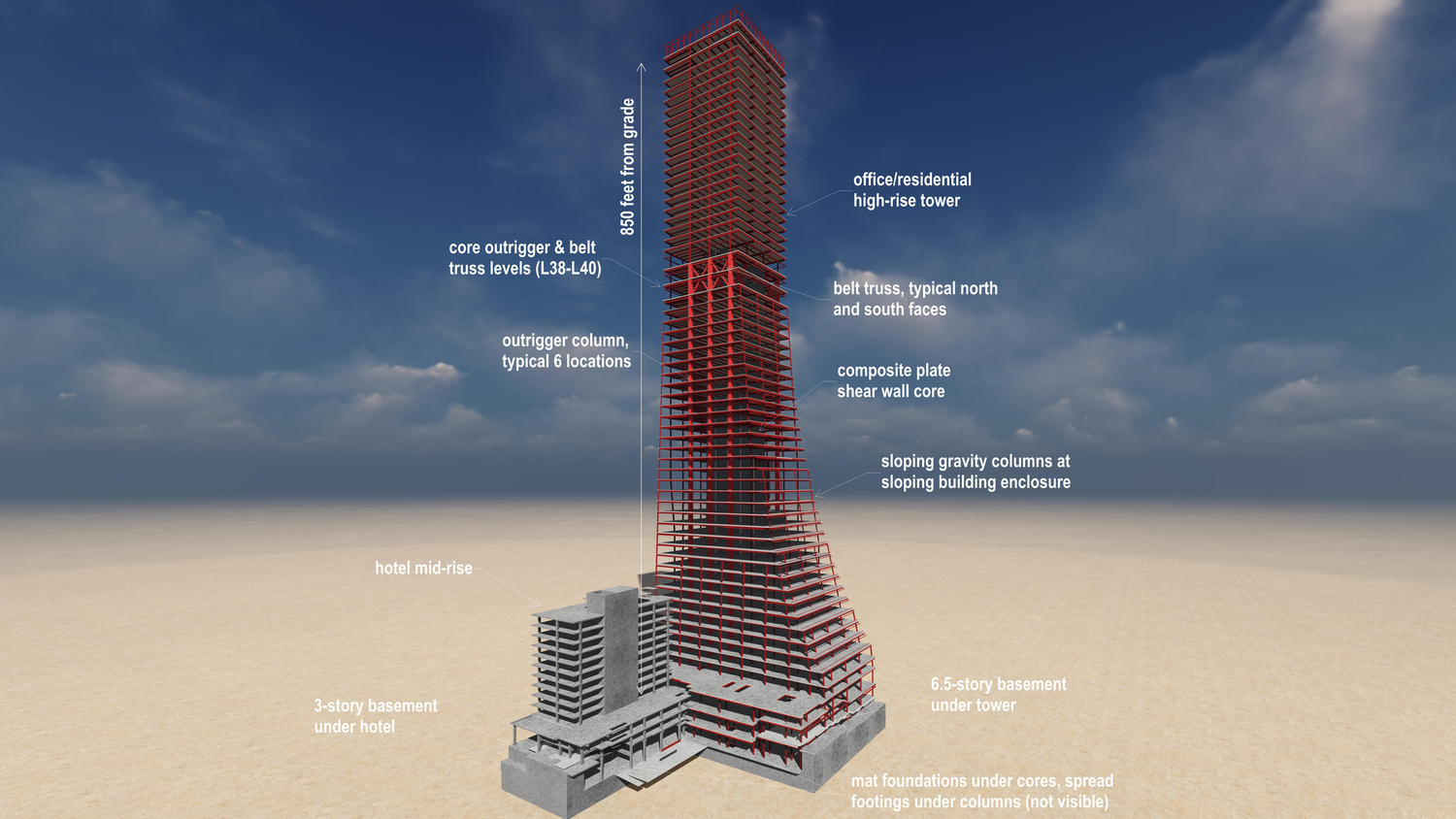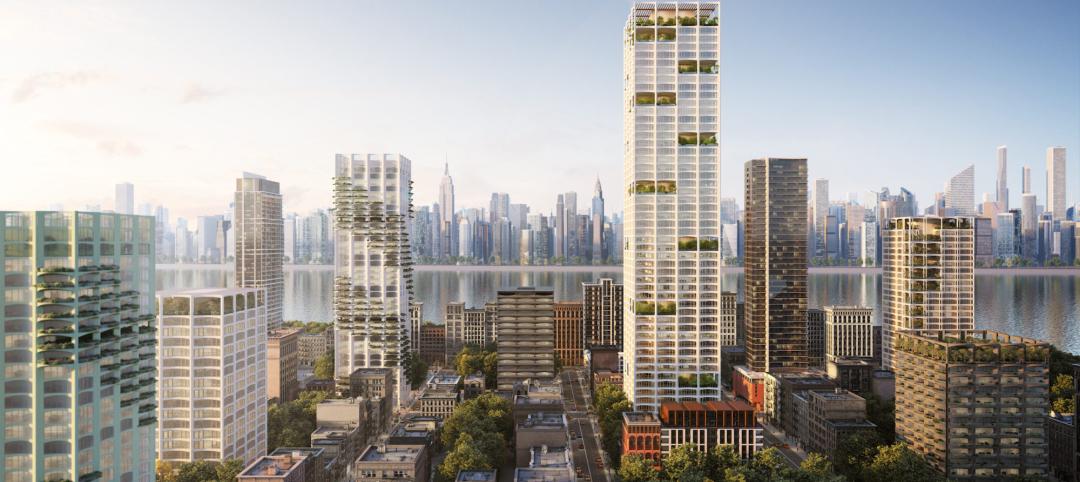Over the past 50 years, high-rise construction had gone through several approaches. In the 1960s, tall buildings were braced around their perimeters, but developers and tenants objected to obstructed views, which led to a shift toward steel cores. That method, however, proved uneconomical, and was replaced, in the 1980s, by structural systems with braces of large composite columns filled with concrete.
The diameters of those columns got in the way of elevators, bathrooms, and corridors, so in the 1990s cores were built with reinforced concrete, which are how most skyscrapers are constructed today.
But construction is still dictated by how fast the core gets built. Enter Speed Core, a steel-and-concrete composite core wall system that uses two steel plates connected by steel spacing ties with a cavity between the plates filled with high-strength concrete.
Magnusson Klemencic Associates (MKA), which spearheaded the development of this concept, is using Speed Core for Rainer Square, a 1.4 million-sf, 850-foot-tall, 58-story apartment and hotel building in Seattle.
 Source: Magnusson Klemencic Associates
Source: Magnusson Klemencic Associates
Through June, 40 stories were finished, and MKA expects construction to take 22 months, saving eight months from what it would have taken to build with a reinforced concrete core.
Ron Klemencic, PE, SE, Hon. AIA, Chairman and CEO, says his firm got the idea for Speed Core after it came across a technique developed in the United Kingdom that was used primarily for blast protection by the defense and nuclear industries.
MKA's R&D journey: A better way to build skyscrapers
In 2007, MKA engaged Purdue University, Klemencic’s alma mater, to research a new steel core system for high-rise buildings. The Charles Pankow Foundation funded the research.
It took three years to come up with a proof of concept for a composite sandwich panel, and another decade to find a client willing to try it on an actual construction project. Developer Wright Runstad & Company, a longtime MKA customer, allowed the firm to pursue this for Rainer Square. The team, which included architect NBBJ, spent six months on the design, which a panel assembled by the city of Seattle reviewed.
There are 240,000 rods used to connect the steel plates that are part of the panels. Purdue and the University of Buffalo are working on the next generation of core design, which Klemencic says might include smaller welds, thinner plates, and one-third fewer rods.
Klemencic says Speed Core aligns with MKA’s ambition to improve with every project. “With Speed Core, we’re living the dream,” he says.
MKA’s two-year-old foundation is funding research into performance-based wind engineering, reducing the carbon footprint in construction materials, and water resource management in buildings.
Related Stories
Architects | Nov 10, 2022
What’s new at 173 architecture firms for 2022
More than 295 U.S. architecture and architecture-engineering (AE) firms participated in BD+C's 2022 Giants 400 survey. As part of the Giants survey process, participating firms are asked to describe their most impactful firm innovations and noteworthy company moves in the past 12 months. Here is a collection of the most compelling business and project innovations and business moves from the 2022 Architecture Giants.
40 Under 40 | Oct 19, 2022
Meet the 40 Under 40 class of 2022
Each year, the editors of Building Design+Construction honor 40 architects engineers, contractors, and real estate developers as BD+C 40 Under 40 awards winners. These AEC professionals are recognized for their career achievements, passion for the AEC profession, involvement with AEC industry organizations, and service to their communities.
Mass Timber | Aug 30, 2022
Mass timber construction in 2022: From fringe to mainstream
Two Timberlab executives discuss the market for mass timber construction and their company's marketing and manufacturing strategies. Sam Dicke, Business Development Manager, and Erica Spiritos, Director of Preconstruction, Timberlab, speak with BD+C's John Caulfield.
Daylighting | Aug 18, 2022
Lisa Heschong on 'Thermal and Visual Delight in Architecture'
Lisa Heschong, FIES, discusses her books, "Thermal Delight in Architecture" and "Visual Delight in Architecture," with BD+C's Rob Cassidy.
Laboratories | Jun 29, 2022
The "collaboratory" brings digital innovation to the classroom
The Collaboratory—a mix of collaboration and laboratory—is a networking center being designed at the University of Denver’s College of Business.
Building Materials | Jun 20, 2022
Early-stage procurement: The next evolution of the construction supply chain
Austin Commercial’s Jason Earnhardt explains why supply chain issues for the construction industry are not going to go away and how developers and owners can get ahead of project roadblocks.
Healthcare Facilities | Jun 20, 2022
Is telehealth finally mainstream?
After more than a century of development, telehealth has become a standard alternative for many types of care.
AEC Business Innovation | Jun 15, 2022
Cognitive health takes center stage in the AEC industry
Two prominent architecture firms are looking to build on the industry’s knowledge base on design’s impact on building occupant health and performance with new research efforts.
Wood | Apr 13, 2022
Mass timber: Multifamily’s next big building system
Mass timber construction experts offer advice on how to use prefabricated wood systems to help you reach for the heights with your next apartment or condominium project.
AEC Tech | Apr 13, 2022
A robot automates elevator installation
Schindler—which manufactures and installs elevators, escalators, and moving walkways—has created a robot called R.I.S.E. (robotic installation system for elevators) to help install lifts in high-rise buildings.
















